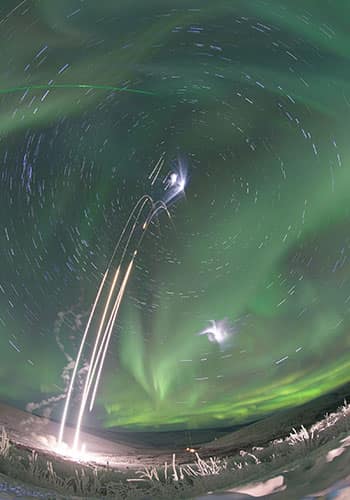
This composite shot of all four rocket experiments (two for MTeX and two for MIST) is made up of 30-second exposures. (Photo: NASA/Jamie Adkins)
The NASA MTeX mission addresses the fundamental question of the contribution of wave-generated turbulence to energetics and mixing in the mesosphere and lower thermosphere (MLT) in the presence of persistent regions of stability and instability. The MTeX mission achieves the above objectives through two similar instrumented rocket campaigns aided by comprehensive, ground-based measurements from the Poker Flat Rocket Range.
The rockets were launched with a time gap of 35 minutes into a persistent mesosphere inversion layer on the morning of Jan. 26, 2015. Each instrumented rocket consists of a multi-surface, fixed-bias DC Langmuir probe (mDCP), Swept Impedance Probe (SIP), Sweeping Langmuir Probe (SLP) and the CONE (Combined measurement of Neutrals and Electrons) sensor. The boom-deployed instruments were contributed by SAIL, whereas the CONE sensor and electronics were from the University of Alaska Fairbanks and the Institute of Atmospheric Physics (Germany).
A good overview of the project can be found in an SPIE paper.
All instruments went through integration and testing at the NASA Wallops Flight Facility in Fall 2014. The integration was supported by Adam Blake, who did his Master of Science in Engineering Physics research work on the mission, and Zachary Laurencio, an undergraduate Engineering Physics student. The booms were designed and built by Finn Carlsvi and Ben Wallace, who were both undergraduate students in the Engineering Physics program. The boom deployment was spin-tested in SAIL at 5Hz on a student-designed and -built spin table. They were also spin-tested during integration and testing at NASA WFF.
The overall contributions from SAIL-built instruments were plasma density measurements in the MLT region for the two flights. The instruments provided high-cadence plasma density measurements that correlated well amongst different instrument types as well as ground-based radar measurements. This is shown in the figure below.

